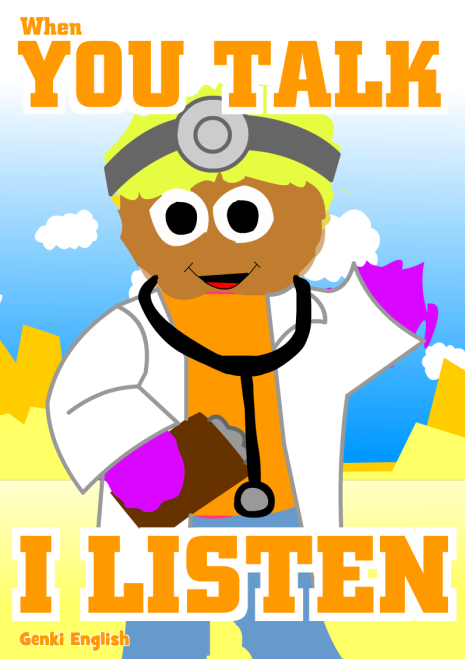 Mark wrote in to ask:
Mark wrote in to ask:
Hi Richard!
In an ESL/TOEFL/IELTS speaking class, how does the teacher get the student to speak more? ย I mean, I read somewhere where it said that this type of class should be 30% speaking belonging to the teacher and 70% speaking for the student.
I find myself in the opposite situation where I’m doing most of the yapping.
Hi Mark,
And in really great classes you can go even further with even upto 80 or 90% of the class where the kids are talking!
That does take a lot of practice (and discipline!) but there are some really easy things you can do right away.
Output Booster
Usually in any class you have two segments, the input – where it is usually the teacher or computer talking – and then the output, where the kids talk.
So one really easy way to do it is to just consciously increase the time for the output part of the lesson.
Really be focussed and make sure you get to each section on time.
At Genki English we do the output with the class games section of the lesson.
And in theย 45 minute lesson planย I usually recommend this to be at least 20 minutes.
(Ninja Tip: ย Click through to each lesson from theย curriculum pageย and you can see my top output games for each lesson.
Ninja Tip 2: ย This is also one extra advantage to using the songs, ย because it gives you a goal to reach when teaching the new vocab. ย And just having a goal speeds you up tremendously!)ย
So if you choose the right games (that have lots of output i.e. student speaking time) ย and keep them as at least half the lesson you should have the balance nearer to normal.
ย
Cops & Robbers
Then after that you can start work on adding more student talking time to the warm ups (e.g. have a look here) or when you introduce new material e.g. here with cops & robbers! ย
Or if you *really* want to improve… video your lessons! ย You will be so shocked at how much we talk in class, which really motivates you to cut it down! ๐
Or if course if you go the whole hog and do the Upside Down classroom where they do the learning at homeย ย then you can get the ratio of student talking time even higher!
I hope that gave you a few ideas.
And for those of you reading, how much time do you spend talking in class? ย Do let us know in the comments! ๐
Be genki,
Richard




I love using stories to cut down on teacher talk time. I put the stories out at each table and the kids try to to tell the stories. The first time, they will be lost. Then, you teach a little bit and give the stories to them again. Wow! Now, they can tell the stories and they can see how much they’ve learned. Sometimes I give them numbers 1-6 and a dice. They role the dice and the kid with the corresponding number reads. Kids love using dice. If you have less than 4 kids in a group, one number means everybody reads together. That is noisy, learning fun!
Great stuff Adam! You do realise of course that we now need to hear these stories from you! ๐
Adam,
I really like these ideas.
Now about the stories~how do you go about with lower level~
when they are not into 3rd person yet.
I think the most time we spend talking is either explanation or discipline, and here teaching in Elementary has really given me lots of experience and made me notice lots of things I wouldn’t have noticed teaching my own private classes.
Instead of explaining, just doing it, (giving an example with the kids acting!)is best and hardly anything needs to be added.
With discipline it is pretty the same; instead of preaching and teaching why what should or shouldn’T be done, I let them get in trouble and mess up ONCE~then just say “stop and sit down”, and ask them what just happened? Was this good for everyone? What could we do to get better results?
It is the kids talking, and needs little time.
NOW< Richard, hardest for me is to shut up with adults~as usually something comes up I'd like to discuss too. I've learned to just keep my mouth closed, and am doing pretty good now.
HOWEVER, there is one student who just likes to state his opinion or talk.
He keeps talking all the time? He asks a question and doesn'T wait for the answer but answers it with his own "suggestions".
It is not that he is so much better in English~it is something he really has to work on. But how can I make him notice in a nice and not offending way~and how to get him shut up?
That’s one reason I use the String Game at the beginning of my workshops.
(They have to introduce themselves and tell us what they want to learn today. )
Now most of the time it is to get the quiet teachers to keep talking longer.
But … it works both ways, in that the talky teachers just keep talking when they’ve finished their string. So I jump in, and say “Oh, no,no,no you’ve finished now!” They get all shocked like no one has ever told them they can’t talk anymore! ๐
And then I go into the Time Management talk about how if you can’t fit everything into the alloted time then you won’t get anywhere!
So I’d try that.
If they are business people you could also try some games like the Elevator Pitch game, where you give them the name of a famous company and they have to pitch it to the class in the time it takes an elevator to descend (usually 30 seconds!)
You could make a Twitter Game or something where they have to get a spoken task done in 140 seconds. It really makes them focus on the efficiency of language and what they can get across in the least time!
This is a wake up call for teachers who love to talk in front of the class. An ideal teacher serves as a facilitor. So in doing this, teacher talk must be minimized. Simple instructions, less explanation, but more of student talk. In an English class be ESL or EFL, students more opportunities to speak so that they will be fully immersed in the language. The best way of learning a language is by speaking. No amount of teacher talk will enable the students to learn how to speak if students are not given more chances of speaking may they pair, group, or even individually.
OK, I have to say teacher talk is a crucial factor in language learning. Students have to hear the language in its correct form before they can learn to produce it.
With GE, students hear the language in the songs which helps it stick. So they produce the language much faster.
However, I have to disagree with making students say the sounds before they can hear them. Especially if they all speak the same first language, you will end up with students producing the language closer to their first language, after all that is what they hear the most.
With correct conscientious modeling, teacher talk is extremely valuable.
I designed my class to be a child centered curriculum where the talkings were made mostly by children. I usually do a circle time after we sing the genki song. In circle time, i asked one question and a child beside me will answer. After that, the child who answer my question will repeat my question and ask another child beside him or her. I do this for young learners but for my big kids, i let them ask question by themselves which is related to the topic or the a question that we learned before.
You will be amazed on some answers and sometimes I laugh because children are funny and tru this question and answer, you will know your students very well or even what happened in their school or at home
I think we she remember that learning a language involves developing both productive and receptive skills. When listening is made creative and engaging, then it is no longer passive.
The percentage of teacher talk I use varies a lot. For true beginners, students must have meaningful input before they can produce Anything. So, I use TPR and then TPRS with beginners. With TPR, it can mean that the teacher talk is 100% of the SPOKEN language. But having students do ACTIONS means that at least one student is acting the language close to 100% of the time. With TPRS, the teacher talk gradually gets reduced, but can be around 80% in the beginning of a cycle at the early stage of using TPRS, dropping down to about 10 or 15% at the end of a cycle, with the kids presenting a story or skit.
For college students at about TOEIC 500 or above, I mostly use task-based learning where it is possible. Over the course of a semester, this results in less than 10% of class time involves the teacher talking in front of the class — though consultation with teams goes on for up to 3/4 of the time or so.
I agree with Kim. This is actually the discussion we are having know in my town. I see my elementary students 10 times a year which is hardly any time. In the demonstration classes many teachers comment that they would have liked to see more time of just students talking.
This may be ideal for older students who have more language, but for these beginning students, they are limited in what they can say. On the other hand they can understand much, much more if given the opportunity.
With TPR and of course GE songs! a teacher can introduce a LOT of language. If you first require them to respond physically with the language, they are engaged and making the connections between sound and meaning. There is a lot going on in their minds.
With the GE songs they use the visuals to understand the meaning. When you examine the songs, you have full sentences including questions and answers. The songs are repetitive and have a melody that gets the language in their heads. The input here is invaluable!
As for other ways like TPR;
Go to the TV. Jump to the door. Touch the chair. etc
You are introducing them to verbs, nouns, and word order. No explanations are needed and you can see how much or how little students understand.
When you want students to “perform” you end up spending a lot of time practicing a very limited amount of language. Of course there will be times when this is the goal, when you want them to gain confidence and when you want them to focus on accuracy.
However in the beginning levels, my choice is to make sure they get lots and lots of accurate input. Students need to hear the correct pronunciation and correct grammar. They need to hear the sounds before they can produce it and they need to hear the language numerous times before they are able to see the patterns within the language.
Since I require students to listen, listen, listen before even asking them to repeat, I see a 10-fold improvement in pronunciation. In TPR and then continuing on to TPRS, I see that my faster processors are picking up on the subtle points of English, and my slower processors are still focused on the meaning and content of the story.
The output may include students retelling the whole story with extra details and ‘grammar'(faster processors) or contributing one-two word details to the story or answering with one-two words to questions asked in English (slower processors).
Either way, students of all levels are being challenged.
Active learning is different from passive learning. Like Kim wrote, active listening is also different from passive listening.
Before teachers decide how much speaking students should do, they first should determine how well the students can speak. If they are truly beginners, you may be exposing them to lots of inaccurate input and taking precious time away from them getting valuable accurate input.
would love to hear more comments about this!
In 10 times a year classes~I think this is out of discussion. So leave this out for now.
But with students I see every week, I want them to be fluent in the language they have learned so far, and this means speak speak speak.
With GE their listening skills are amazing anyway, just from doing the games at home or listening to the songs.
I just gave my 3rd graders “jingle bell rock” to remember for HW, without even playing it in class, and all of them, just by listening are better than I am (I am also trying to remember it for the first time now),
same with the original of 12 days of Christmas~they pick up the sounds so effortlessly! I am amazed every time.
But they still need much more time for speaking, and this is because I am still too involved. To pull back more was my goal for this year, regarding teaching. And looking at our Skype session videos, and my position when holding events, I should give myself a star for now, as you hear my voice much less than before, and the kids are much more involved! But I am not there yet!
As for adults, I was pretty much down to about 20 % teacher talk, but talking to my students, they want to listen more to “real” English than to English spoken by their classmates.
So, this is a difficult one for me.
And I, who teach 3rd to 6th graders, in Israeli schools, agree that active learning and listening is the real way to encourage speaking and true language learning. The name of the game is “fun” which Genki English is all about. I began the school year this September in a very difficult 3rd grade all boys class. As always, I began the lesson on the first day asking them how they learned their mother tongue, Hebrew, to which they replied “by listening to how their parents spoke to them telling them what to do”. From their I proceeded to tell them that that is exactly how we will be learning English, through listening and doing! And so…….Till now my 3rd graders can all : run and jump and walk and clap and stamp feet and swim and fly and be “Super Heroes” of course, and insist on reversing roles….which is the greatest output you can have of course!
And then…..I have my two puppets which I bring to my classes every beginning of the year.
Here, even the shyest kids will answer questions they hear from the puppets and speak and say : “My name is ______ . I am fine thank you! Nice to meet you, too”!
In conclusion, as I always say, REAL language learning is through comprehending , moving, doing and finally speaking-
Thank you as usual to Richard and Genki English for helping us to make this a fun reality!